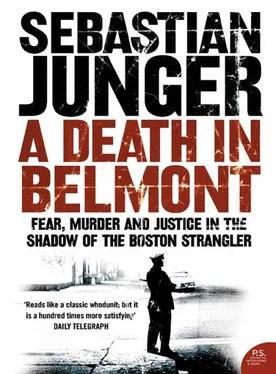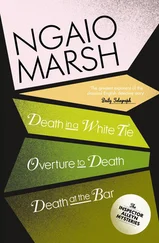
SEBASTIAN JUNGER

FOR MY MOTHER, ELLEN SINCLAIR JUNGER
And they said to the Prophet, “How may we stop our ears to the rant of the fool and yet show him charity?”
And he answered, “You show yourselves charity by opening wide your ears to him. The fool in the midst of his babble shall speak truths which the minds of the wise cannot perceive.”
—unattributed quote pinned to the office
wall of a Massachusetts appellate lawyer
Cover
Title Page
Dedication
Epigraph
A Note on Quotes
Part 1: The Murder
One
Two
Three
Four
Five
Six
Seven
Eight
Nine
Ten
Part 2: The Trial
Eleven
Twelve
Thirteen
Fourteen
Fifteen
Sixteen
Seventeen
Part 3: The Confessions
Eighteen
Nineteen
Twenty
Twenty-one
Twenty-two
Twenty-three
Twenty-four
Twenty-five
Twenty-six
Twenty-seven
September 2005
Further Reading
Acknowledgments
About the Author
Praise
Other Works
Copyright
About the Publisher
If a passage is enclosed in quotation marks in this book, it means that the person was speaking into a tape recorder or before a court stenographer. In some instances I wrote my interviews in notebooks, but that was rare; almost all my interviews were done with a tape recorder. Conversations in this book were obviously not recorded as they happened, so they never take quotation marks. As reproduced in this book, however, they do faithfully represent the recollections of the people involved. In all cases—including in some published texts—I have made grammatical changes for the sake of clarity, as well as minor edits for the sake of brevity.
THE MURDER
ONE MORNING IN the fall of 1962, when I was not yet one year old, my mother, Ellen, looked out the window and saw two men in our front yard. One was in his thirties and the other was at least twice that, and they were both dressed in work clothes and seemed very interested in the place where we lived. My mother picked me up and walked outside to see what they wanted.
They turned out to be carpenters who had stopped to look at our house because one of them—the older man—had built it. He said his name was Floyd Wiggins and that twenty years earlier he’d built our house in sections up in Maine and then brought them down by truck. He said he assembled it on-site in a single day. We lived in a placid little suburb of Boston called Belmont, and my parents had always thought that our house looked a little out of place. It had an offset salt-box roof and blue clapboard siding and stingy little sash windows that were good for conserving heat. Now it made sense: The house had been built by an old Maine carpenter who must have designed it after the farmhouses he saw all around him.
Wiggins now lived outside Boston and worked for the younger man, who introduced himself as Russ Blomerth. He had a painting job around the corner, Blomerth said, and that was why they were in the neighborhood. My mother said that the house was wonderful but too small and that she and my father were taking bids from contractors to build a studio addition out back. She was an artist, she explained, and the studio would allow her to paint and give drawing classes at home while keeping an eye on me. Would they be interested in the job? Blomerth said that he would be, so my mother put me in his arms and ran inside to get a copy of the architectural plans.
Blomerth’s bid was the low one, as it turned out, and within a few weeks he, Wiggins, and a younger man named Al were in the backyard laying the foundation for my mother’s studio. Some days all three men showed up, some days it was Blomerth and Wiggins, some days it was just Al. Around eight o’clock in the morning my mother would hear the bulkhead door slam, and then she’d hear footsteps in the basement as Al got his tools, and then a few minutes later she’d watch him cross the backyard to start work. Al never went into the main part of the house, but sometimes my mother would bring a sandwich out to the studio and keep him company while he ate lunch. Al talked a lot about his children and his German wife. Al had served with the American forces in postwar Germany and been the middleweight champion of the American army in Europe. Al was polite and deferential to my mother and worked hard without saying much. Al had dark hair and a powerful build and a prominent beak of a nose and was not, my mother says, an unhandsome man.
My mother was born in Canton, Ohio, the year of the stock market crash to a nightclub and amusement park owner named Carl Sinclair and his wife, Marjorie. Canton was a conservative little city that could be stifling to a woman who wanted more than a husband and children—which, as it turned out, my mother did. She wanted to be an artist. At eighteen she moved to Boston, went to art school, and then rented a studio and started to paint. Her parents looked on with alarm. Young women of her generation did not pass up marriage for art, and that was exactly what my mother seemed to be doing. A few years went by and she hadn’t married, and a decade went by and she still hadn’t married, and by the time she met my father, Miguel, in the bar of the Ritz Hotel her parents had all but given up.
When my mother finally got married at age twenty-nine it was welcome news, but my father could not have been exactly what her parents had envisioned. The son of a Russian-born journalist who wrote in French, and a beautiful Austrian socialite, he had come to the United States during the war to escape the Nazis and study physics at Harvard. He spoke five languages, he could recite the names of most of the Roman emperors, and he had no idea how the game of baseball was played. He also had made it to age thirty-seven without getting married, which alarmed any number of my mother’s female friends. Against their advice she eloped with him to San Francisco, and they were married by a judge at the city hall. A year later my mother got pregnant with me, and they bought a house in a pretty little suburb called Belmont.
The studio they built, when it was finally finished, had a high cement foundation set into a slight hill and end walls of fir planks with a steep-pitched shingle roof that came down almost to the ground. There was a Plexiglas skylight at the roof peak that poured light onto the tile floors, and there was a raised flagstone landing that my mother populated with large plants. The job was completed in the spring of 1963; by then Blomerth and Wiggins had moved on to other work, and Al was left by himself to finish up the last details and paint the trim. On one of those last days of the job, my mother dropped me off at my baby-sitter’s and went into town to do some errands and then picked me up at the end of the day. We weren’t home twenty minutes when the phone rang. It was the baby-sitter, an Irishwoman I knew as Ani, and she was in a panic. Lock up the house, Ani told my mother. The Boston Strangler just killed someone in Belmont.
The victim’s name was Bessie Goldberg, and she had been found by her husband raped and strangled in their home on Scott Road. Several days earlier, a sixty-eight-year-old woman named Mary Brown had been raped and bludgeoned to death in the small town of Lawrence, north of Boston. They were the eighth and ninth sex murders in the Boston area in almost a year, and the city was in a state of terror. My mother rushed out to the studio where Al was painting on a ladder and told him the news. It’s so scary, my mother remembers telling him. I mean, here he is in Belmont, for God’s sake! Al shook his head and said how terrible it was, and he and my mother talked about it for a while, and eventually she went back into the house to start dinner.
Читать дальше














